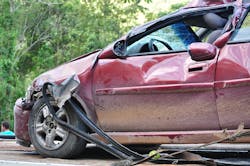2016 Motor Vehicle Deaths Highest in 9 Years
Feb. 16, 2017—For the first time in nearly a decade, preliminary 2016 data from the National Safety Council estimates that as many as 40,000 people died in motor vehicle crashes last year. That marks a 6 percent increase over 2015, and a 14 percent increase over 2014—the most dramatic two-year escalation since 1964.
The preliminary estimate means 2016 may have been the deadliest year on the nation's roads since 2007. An estimated 4.6 million additional roadway users were seriously injuredi in 2016, and estimated cost to society was $432 billion.
A National Safety Council survey provided a glimpse at the risky things drivers are doing. Although 83 percent of drivers surveyed believe driving is a safety concern, a startling number said they are comfortable speeding (64 percent), texting either manually or through voice controls (47 percent), driving while impaired by marijuana (13 percent), or driving after they feel they've had too much alcohol (10 percent).
Motor vehicle fatality estimates are subject to slight increases and decreases as data mature. The National Safety Council uses data from the National Center for Health Statistics, an arm of the CDC, so that deaths occurring within 100 days of the crash and on both public and private roadways—such as parking lots and driveways—are included in the Council's estimates.
"Our complacency is killing us. Americans believe there is nothing we can do to stop crashes from happening, but that isn't true," said Deborah A.P. Hersman, president and CEO of the National Safety Council. "The U.S. lags the rest of the developed world in addressing highway fatalities. We know what needs to be done; we just haven't done it."
With the upward trend showing no sign of subsiding, the National Safety Council is calling for immediate implementation of life-saving measures that would set the nation on a road to zero deaths:
- Mandatory ignition interlocks for convicted drunk drivers and better education about the nature of impairment and when it begins.
- The installation and use of automated enforcement techniques to catch speeders.
- Laws banning all cell phone use, including hands-free, should extend to all drivers, not just teens. States with existing bans need to upgrade enforcement from secondary to primary.
- Seat belt laws should be upgraded from secondary to primary enforcement and restraint laws should extend to every passenger in every seating position, in all kinds of vehicles.
- All new drivers under 21, not just those under 18, should adhere to a three-tiered licensing system.
- Automotive safety technologies that have life-saving potential should be standardized and accelerated into the fleet. These technologies include blind-spot monitoring, automatic emergency braking, lane departure warning and adaptive headlights.
- Motorcycle helmet laws should be passed or reinstated.
- Communities and municipalities should adopt comprehensive programs for pedestrian safety.
